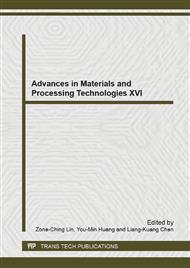p.491
p.499
p.506
p.517
p.524
p.530
p.539
p.547
p.555
A Study on the Warm Forging-Flaring Process of Brass Tube
Abstract:
At present, quite a lot of enterprises, small or medium-sized, are engaged in developing the various necessaries of livelihood. And, the forming processes are generally adopted for the methods of parts manufacture. Though various forming technology progress rather well, but the warm working process often cannot obtain fine finished products in the process of manufacturing. The warm working process still needs more adequate techniques. This study is focused on the analyzing of the warm forging-flaring process of brass tube, and the improving of the die design and the working procedures. In this paper, two sets of forging and flaring die are designed for experimental works. The results of simulation are compared with the experiments, the formability of brass tube showed a good agreement. Therefore, we suggest a multi-pass of forging process instead of single-pass process. The stress distributions and loading history in forming processes are also assessed in details. The method used in this study is available in the relative warm forming processes and die design. It is helpful to increase the additional value of products and promote the level of competition in manufacturing industry.
Info:
Periodical:
Pages:
524-529
Citation:
Online since:
May 2014
Authors:
Keywords:
Price:
Сopyright:
© 2014 Trans Tech Publications Ltd. All Rights Reserved
Share:
Citation:


